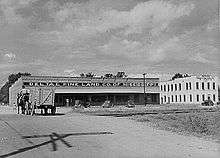Delta & Pine Land Company of Mississippi
 Offices of Delta & Pine Land Company in 1939 | |
| Industry | Agribusiness |
|---|---|
| Headquarters | Scott, Mississippi, United States |
| Products | Cotton and soybean seeds |
| Parent | Bayer (2018)[1][2] |
Delta & Pine Land Company was initially chartered in Mississippi in 1886 as a land speculation company, but was inactive until 1919, when a British textile company acquired the name. In the 1920s and 1930s, the company operated one of the largest cotton plantations in the Mississippi Delta, with headquarters in Scott, Mississippi.[3] In the latter half of the 20th century, the company divested its farm lands, concentrated on research and development of cotton and soybean seeds, and became world-renowned for its development of Deltapine cotton varieties.[4]
History
The original Delta and Pine Land (D&PL) Company was chartered in 1886 in the state of Mississippi, under laws that allowed almost unlimited land holdings by a single company.[5] State laws were later changed to restrict land acquisition and ownership, but these laws did not apply retroactively to companies that were grandfathered in under older laws.
In 1911, Fine Cotton Spinners’ and Doublers’ Association Ltd. (FCSDA) of Manchester, England, purchased large tracts of land—38,000 acres (15,000 ha)—in the Mississippi Delta for cotton production.[5] In order to comply with state law regarding land ownership, FCSDA created three companies—Lake Vista Plantation Company and Triumph Plantation Company owned land, while Mississippi Delta Planting Company leased the land and operated it as one unit. In 1919, FCSDA acquired the inactive charter of D&PL, and merged its three smaller companies under that title with headquarters in Memphis, Tennessee.[5] In 1927, D&PL moved its headquarters to Scott, Mississippi, where it remained.
In the 1930s, D&PL operated the largest cotton plantation in the U.S., with more than 9,000 acres (3,600 ha) under cultivation.[4] The average yield for cotton in the 1920s was less than 200 lb (91 kg) per acre (0.4 ha),[6] but D&PL was producing an average of 650 lb (290 kg) of cotton fiber per acre (0.4 ha) and 980 lb (440 kg) of seed by the 1930s.[4] D&PL introduced their Deltapine cotton variety in 1942.[4] After World War II, D&PL cotton varieties were being planted throughout the southern U.S., from Texas to North Carolina.
During the 1960s-1970s, D&PL began expanding into the western U.S, with offices in California, Arizona, and Texas.[4] New cotton varieties were bred specifically for the drier climates, typical in the western states.
In 1964, FCSDA was acquired by Courtaulds, another British textile company. And in 1978, Courtaulds sold D&PL, in a leveraged buyout, to U.S. investors (Southwide, Inc. of Memphis).[4][7] During the years that followed, most of the D&PL farm acreage was sold and the company concentrated on research and development of improved varieties of cotton and soybean seeds.[5]
Research
D&PL became the world’s largest cotton breeder, doing business in the U.S and in 18 other countries.[7] In its cotton breeding research, D&PL was able to develop gene pools that produced cotton varieties of benefit to both cotton farmers, through increased yields, and textile manufacturers, through enhanced fiber traits.[8]
Other research successes included development of early maturing varieties, transgenic row-crop seeds, and the first Roundup Ready cotton seeds.[7] By the mid-1980s, D&PL was marketing ten varieties of cotton seeds and six varieties of soybean seeds.[4]
In the 1990s, research between D&PL and the U.S. Department of Agriculture resulted in three U.S. patents on terminator seed technology.[9] The first patent (Number 5723765) was issued on March 3, 1998.[10][11] Advocates claimed that the technology restricted the introduction of genetically modified plants into nature by causing second generation seeds to be sterile. The opposing point of view was that farmers who used terminator seeds could no longer rely on saved seeds to produce subsequent crops.
Acquisition
During the 1990s, D&PL had entered into successful research ventures with Monsanto. In 1998, Monsanto agreed to merge with D&PL, but the agreement collapsed under antitrust scrutiny by the Department of Justice.[4] By 2006, antitrust concerns were reduced because of changing market conditions and competition from Bayer CropScience. Subsequently, Monsanto made an offer to buy D&PL, and in June 2007, D&PL became a wholly owned subsidiary of Monsanto.[12][13]
In September 2016, Monsanto agreed to a takeover offer by Bayer, pending regulatory approval.[14] On June 7, 2018, Bayer completed its acquisition of Monsanto[2] following approval by the European Union on March 21, 2018,[15] and the United States on May 29, 2018.[16]
References
- ↑ Monsanto completes purchase of Delta & Pine Land—St. Louis Business Journal (June 1, 2007) Retrieved 2013-12-07
- 1 2 Daniels, Jeff (2018-06-07). "Germany's Bayer closes $63 billion Monsanto takeover, plans to drop US company's name". CNBC. Retrieved 2018-06-23.
- ↑ Delta and Pine Land Company Records (1886-1982) Retrieved 2013-12-04
- 1 2 3 4 5 6 7 8 Delta and Pine Land Company Facts Retrieved 2013-12-06
- 1 2 3 4 Delta and Pine Land Company Records MSS.101 Retrieved 2013-12-04
- ↑ Encyclopedia of Alabama: Cotton Retrieved 2013-12-07
- 1 2 3 Roger Malkin Honored As Recipient of Cotton Industry Achievement Award Retrieved 2013-12-04
- ↑ Delta and Pine Land Company History Retrieved 2013-12-04
- ↑ USDA and Delta & Pine Land conclude negotiations on terminator patent Retrieved 2013-12-05
- ↑ United States Patent 5723765 Retrieved 2013-12-07
- ↑ The controversy of Terminator Technology Retrieved 2013-12-05
- ↑ Company overview of Delta and Pine Land Company, LLC—Bloomberg Businessweek Retrieved 2013-12-06
- ↑ Monsanto Company Completes Acquisition of Delta and Pine Land Company, Seeks Approval of Related Divestitures Retrieved 2013-12-07
- ↑ "Chemical Giant Bayer Agrees To Buy Monsanto For $66 Billion". National Public Radio. Retrieved 2017-02-26.
- ↑ "Bayer Clears EU Hurdle for Monsanto Deal With Sale to BASF". Bloomberg.com. Retrieved 2018-06-23.
- ↑ "Mega deal: Bayer-Monsanto $66B merger wins conditional Department of Justice approval". USA TODAY. Retrieved 2018-06-23.